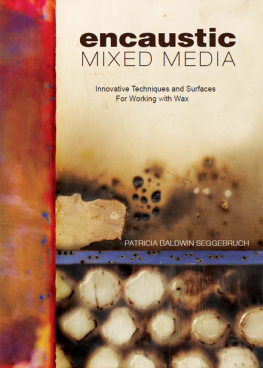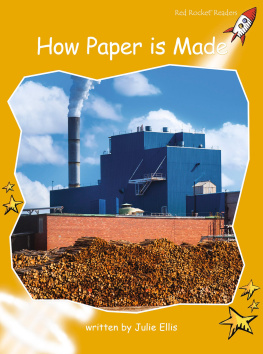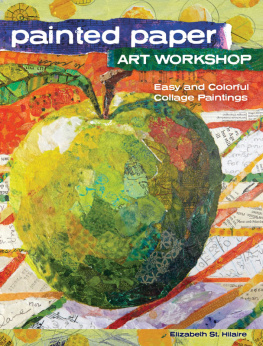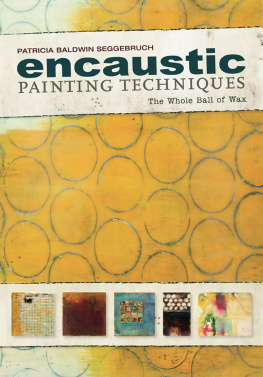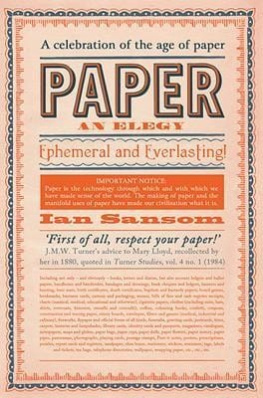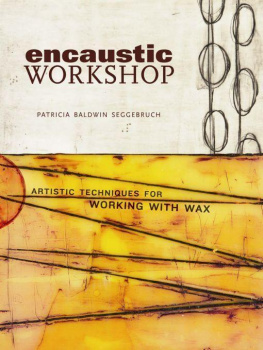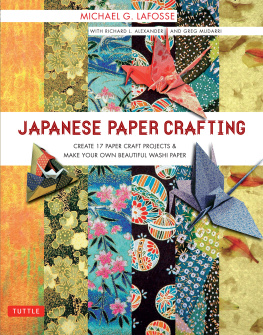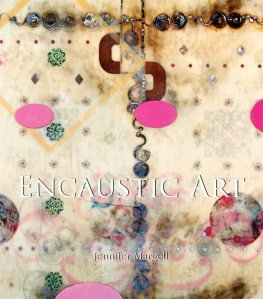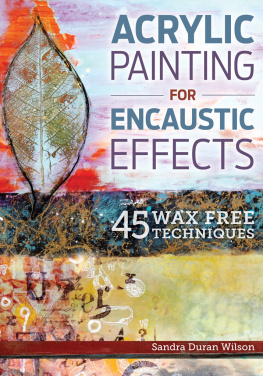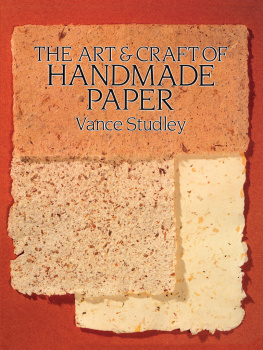Wax and Paper Workshop
Techniques For
Combining Encaustic Paint
And Handmade Paper
Michelle Belto
contents
GALLERY: SEARCHING FOR BALANCE
I began marking this wet piece of paper with ink. You can see that under painting through the top half of the work. The texture was created using a metal dental tool heated on the pallet. I liked the way the marks of the tool revealed the original layer of paint.(cotton, abaca, beeswax, resin, pigment)
Introduction
Almost everyone who works in wax has come to this medium through another discipline. Todays leading encaustic painters began their careers as printmakers or sculptors or mixed media artists. Most artists come to encaustic painting because the wax adds an exciting dimension to their work. Some artists fully embrace encaustic and continue to explore and expand their tool bag, while others move back to their original modalities, using wax as one ingredient in the process. I came to wax through papermaking.
At the beginning of my visual art career, I was a fiber artist working with silks, dyes and stitchery on fabric. In the early 1990s, while taking some post-graduate courses at the Southwest School of Art, I discovered paper and began my lifelong love affair with pulp. I am fascinated with the versatility of paper. It can be formed, cast, sculpted, pulp painted, collaged, embossed, blown, stretched and used in many other ways I have yet to discover.
From the beginning, I was less interested in creating sheets of paper and more concerned with working larger and more sculptural. I first explored paper as a bas-relief, finding ways to move beyond the typical rectangular or square format and into interesting shapes with several dimensional layers. It was only much later that I began to think of these cast paper works as canvases for paint. I had tried a variety of ways to add color over the years but hadnt found anything that provided the brilliance of the silk dyes that were part of my surface design experience.
A few years ago, I was lunching with a friend, sharing my frustration in working with acrylic paint on paper. She advised me to try wax. I was intrigued, having never experienced encaustic painting. I couldnt fathom how one could paint with molten beeswax. After some research and a lot of trial and error (mostly error) I came to believe that wax is the perfect partner for paper. Surprisingly, for me the lure of wax has become as strong as my attraction to paper. My work today is about the exploration of these two organic mediums: paper and wax. The encaustic process of painting and scraping, melting and molding the wax allows me to be inventive in a way that is both immediate and spontaneous. The process of making my own paper substrate opens limitless doors for experimentation. In these two media, I believe I will have enough material to explore for the rest of my life.
How to Use This Book
Painting with wax is immediate; paper takes time to dry. For that reason, Ive set up the book into two sections: In the Paper Studio and In the Encaustic Studio. Some readers might like to set up a paper studio and then go through each of the demonstrations of making paper, cutting supports, and wrapping and casting paper to amass a whole body of delicious canvases in preparation for the wax. The wax process has the advantage of having a huge variety of supports ready for experimentation. Other readers will like to move back and forth between the two studios, making paper and using it as soon as it is dry. Some of the processes in the chapter Before the Wax actually require that the paper be fresh and wet, so it is possible to make paper and then begin to work with it immediately.
Some of you may know something about encaustic, but very little about the paper process or vice versa. You might want to select those techniques that are new to you or focus on only one part of the book. However you choose to use this book, I know that you will enjoy the experience of working with these two organic and renewable resources. I am excited to share my enthusiasm and my years of explorations with you, and I look forward to seeing where your own experiments take you.
In the Paper Studio
ADVANTAGES OF A PAPER CANVAS
Paper is a perfect complement to wax. Wrapped around a rigid support, such as gator board, foam core or foam panel, paper can successfully handle two challenges of encaustic paint: weight and temperature.
Many artists use wood or cradled panel for their encaustic supports, but paper has several advantages over more traditional substrates. With wood, the larger the work, the heavier it becomes. The heavy weight precludes many artists from working on a sizeable scale. With a paper canvas, there is very little weight. In fact, a 36 36 (91cm 91cm) canvas can be lifted and carried with one hand. Even though my work appears to be solid and heavy, many people are surprised by how lightweight it actually is.
Temperature is a worry to many encaustic artists who go to great lengths to ship their work only during moderate times of the year to avoid melting, chipping and cracking. A paper canvas is not as susceptible to temperature fluctuations because neither the paper nor its rigid interior support conducts heat or cold. The paper as described in this book is created thick and without sizing, making it highly porous and wax thirsty. I have shipped my work by ground without worry and without incident both in the dead of winter and the heat of summer. If boxed properly, these canvases are shipping friendly, impervious to the ordinary nicks and chips of handling and resistant to the extremes of climate conditions.
Ive always been attracted to work that was non-traditional in shape, size or dimension. With these supports, I especially like the fact that I have the ability to begin my idea with the canvas itself. My canvas can be a circle or shape as easily as it can become a more traditional square or rectangle. I can incorporate the deckle of the paper or wrap the paper to create a classic canvas. I can add dimensionality or texture, create windows or levels and add to the natural texture of the paper with imbedded patterns.
Paper is versatile. While the paper is still being formed, I can color the pulp, add fibers and botanicals, emboss or create pattern. When the sheet of paper is wet and wrapped on the support, I can spritz it with watercolor, draw on it with inks or add objects to rust. When the paper support is dry, I can distress it with a torch and add texture with screened-on grout. And that is all before I even apply the wax! You might even find that you like your canvas without any encaustic paint or other media.
GALLERY: CIRCLE SQUARED
In this work, I explored the relationship between the circle (dynamic) and the square (static). I chose to create this larger work with nine white cast paper panels because the papers curvilinear deckle created a kind of dynamic energy between the square panels. I like the way the viewer first is drawn into the works dimensionality and texture and then finds a surprise as the image comes into focus when he moves farther away.(cotton, abaca, beeswax, resin, white pigment)
Next page

